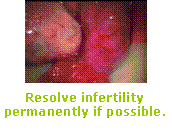
|
The fallopian tubes are part of the female reproductive system, along with the vulva, the vagina, the uterus and the ovaries. The fallopian tubes are two tubal structures that can measure between 7 and 12 cm, formed basically by smooth muscle, covered by a peritoneal layer and in the interior they are lined by a delicate epithelium, that is specialized in the transfer of the egg and the embryo. They are joined to the upper part of the uterus in the proximal extreme, to each one of the two ovaries in the distal extreme and to the support structures of the uterus in almost the entire length of the inferior face. The fallopian tubes have morphological variations in the longitudinal sense : they are narrower, with a thicker muscular cover in the proximal part, and they are bigger and more elastic in the distal sense. They end in a structure called tubal fimbria, formed by multiple digitations of the mucosa layer, open to the abdominal cavity and capable of sweeping the entire surface of the ovary, to which they are fixed by only one of these. The fallopian tubes, then, have as their functions, the capture of the egg when it is released from the ovary, at the moment of ovulation, and the transfer of the egg in their interior where eventually it will meet with the sperm that ascend from the vagina, achieving fertilization in the ampullar portion. The first stages of development of the embryo occur in the fallopian tubes, during the four days that it takes for its transfer to the uterine cavity, lined by the endometrium, where finally it is implanted.
DIAGNOSIS Today there are five diagnostic techniques that are used to explore the tubal factor in the sterile patient. One, the hysterosalpingography, is radiological, the other, the hysterosalpingosonography is based on ultrasound, the two following, salpingoscopy and laparoscopy, are endoscopic and, as a final test we include the tests for Chlamydia. The hysterosalpingography and the laparoscopy were the first to be used, they are the most widespread and generally considered to be the most useful, both complement each other and allow for an adequate study of the tubes. The other two techniques also contribute interesting aspects. LAPAROSCOPIC SURGERY OF TUBAL INFERTILITY The progress made over the past few years in laparoscopic surgery has brought about considerable changes in the management of patients presenting with tubal infertility. It is important to clarify the place of laparoscopic surgery in this indication relative to the other possible treatments. Reconstructive operative laparoscopy have precise indications in |


|
To contact me: |
